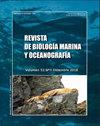智利北部沿海上升流系统Chipana湾(21º20'S)浮游细菌组成的时间和垂直变化:荧光原位杂交方法
IF 0.5
4区 生物学
Q4 MARINE & FRESHWATER BIOLOGY
引用次数: 0
摘要
采用荧光原位杂交(FISH)技术,对南太平洋热带东部氧最低带(OMZ)上升流系统中与海洋学条件相关的浮游细菌进行了可视化计数研究。研究了6个不同的分类类群(α、β、γ -proteobacteria、Cytophaga-flavobacterium和Archaea和Bacteria)。分析显示,细菌结构域(占杂交细胞的20% ~ 68%)比古细菌结构域(占杂交细胞的2% ~ 18%)更占优势。特异性类群表明,细胞噬菌-黄细菌、α -变形细菌和γ -变形细菌在表层数量较多。γ -变形菌属在深层氧层中也是最丰富的,β -变形菌属是记录丰度最低的一类。通过NMDS观察了水柱中细菌群落在OMZ和oxycline之间垂直分布的变化。这种变化是由于上升流的松弛期引起的叶绿素浓度低,导致表层中特定的细胞噬菌-黄杆菌和γ -变形菌群丰度发生变化的产物。本文章由计算机程序翻译,如有差异,请以英文原文为准。
Temporal and vertical variability of bacterioplankton composition in Chipana bay (21º20’S) in a coastal upwelling system of northern Chile: A fluorescence in situ hybridization approach
The bacterioplankton in the upwelling systems associated with oceanographic condition of the oxygen minimum zone (OMZ) of the Eastern tropical South Pacific was studied through visualization and enumeration with fluorescent in situ hybridization (FISH). Six different taxonomic groups were studied ( Alpha, Beta, Gamma-proteobacteria, Cytophaga-flavobacterium and the domains Archaea and Bacteria ). The analysis showed a greater predominance of the Bacteria domain (20 to 68% of hybridized cells) over Archaea (2 to 18% of hybridized cells). The specific groups showed that Cytophaga-flavobacterium , Alpha-proteobacteria and Gamma-proteobacteria are more abundant in the surface layer. Gamma-proteobacteria is also most abundant in the deep oxycline and, Beta-proteobacteria is the group with the lowest registered abundances. Changes in the vertical distribution of the bacterial community in the water column between OMZ and on oxycline were observed through NMDS. This change is a product of a shift in the abundances of the specific groups Cytophaga-flavobacterium and Gamma-proteobacteria in the surface layers, due to low concentration of chlorophyll- a caused by periods of relaxation in the upwelling.
求助全文
通过发布文献求助,成功后即可免费获取论文全文。
去求助
来源期刊
CiteScore
0.70
自引率
0.00%
发文量
41
审稿时长
12 months
期刊介绍:
Publicar desde una perspectiva científica, artículos originales, decididos por un proceso de revisión por pares, invitando a expertos de reconocido prestigio en el área. Los trabajos publicados se caracterizarán por su solidez teórica-metodológica, actualidad y relevancia para las ciencias marinas.
Se reciben trabajos inéditos derivados de la investigación científica realizada en ambientes marinos y estuarios, en formato de Revisión, Artículos, Notas Científicas, y Obituarios en las siguientes disciplinas::
Biología-Ecología marina
Oceanografía física, química y biológica
Contaminación marina
Geología marina
Sistemática, Faunística y Biogeografía Marina
Manejo Costero
Acuicultura marina
Pesquería marina.

 求助内容:
求助内容: 应助结果提醒方式:
应助结果提醒方式:


